Georgian lari facts for kids
Quick facts for kids Georgian lari |
|||||
|---|---|---|---|---|---|
|
|||||
| ISO 4217 Code | GEL | ||||
| User(s) | |||||
| Inflation | 0.0% (February 2024) | ||||
| Source | National Bank of Georgia | ||||
| Subunit | |||||
| 1⁄100 | tetri | ||||
| Symbol | ₾, ლ, | ||||
| Plural | The language(s) of this currency does not have a morphological plural distinction. | ||||
| Coins | 5, 10, 20, 50 tetri, ₾1, ₾2 | ||||
| Banknotes | |||||
| Freq. used | ₾5, ₾10, ₾20, ₾50, ₾100 | ||||
| Rarely used | ₾1, ₾2, ₾200 | ||||
| Printer | Polish Security Printing Works | ||||
The lari (Georgian: ლარი; ISO 4217: GEL) is the official money of Georgia. It is split into 100 smaller units called tetri (თეთრი). The word lari is an old Georgian word meaning "property" or "treasure." The word tetri means "white" and was used for money in ancient Colchis as far back as the 6th century BC.
Contents
Kuponi: Georgia's First Currency
Before the Lari, Georgia used a temporary currency called the kuponi (Georgian: კუპონი). This happened on April 5, 1993, when Georgia replaced the Soviet ruble.
The kuponi only came in paper money (banknotes) and had no smaller parts like coins. It also suffered from hyperinflation, which means prices rose very, very quickly. Because of this, banknotes were printed in huge amounts, from 1 to 1 million kuponi. Some unusual values included 3,000, 30,000, and 150,000 kuponi notes.
- Some of the largest kuponi banknotes
The Lari: Georgia's Stable Money
On October 2, 1995, the Georgian government, led by Eduard Shevardnadze, introduced the Lari. It replaced the kuponi at a rate of one million kuponi for just one Lari. Since then, the Lari has been quite stable.
The Lari Sign
In December 2013, the National Bank of Georgia (NBG) held a competition to design a special symbol for the Lari. A group of experts from different government and cultural organizations chose the winning design.
On July 8, 2014, Giorgi Kadagidze, who was the Governor of the NBG, showed the winning symbol to the public. The artist who created it was Malkhaz Shvelidze, a professional artist-ceramist.
The experts chose the symbol based on several things. They looked for designs that used the Georgian Mkhedruli writing style. They also wanted a symbol that was easy to understand and looked like a currency sign.
The Lari symbol looks like the Georgian letter ლ (Lasi). It's common for currency symbols to be a letter with one or two lines crossing it. The Lari sign has two parallel lines crossing the Lasi letter. These lines give the symbol a strong and stable look.
Later, on July 18, 2014, the National Bank of Georgia asked the Unicode Consortium to add the Lari symbol to the worldwide standard for computer characters. On June 17, 2015, the Lari sign was officially added to Unicode as:
- ₾
U+20BE GEORGIAN LARI SIGN
Lari Coins
Georgia uses coins in values of 5, 10, 20, and 50 tetri, as well as 1 and 2 lari.
The National Bank of Georgia announced that 1 and 2 Tetri coins would no longer be used after January 1, 2021. You could exchange these coins at the National Bank or other banks for a year. After January 1, 2022, you can only exchange them at the National Bank of Georgia.
Also, new rules for cash payments started on January 1, 2019. If a price ends in 1 or 2 tetri, it's rounded down to 0. If it ends in 3, 4, 6, or 7 tetri, it's rounded to 5 tetri.
The old 50 Tetri coin from 1995 was also taken out of use on January 1, 2018. You could exchange these old coins for a year at banks. After January 1, 2019, you can only exchange them at the National Bank of Georgia.
| Second Series (2006) | ||||||||
|---|---|---|---|---|---|---|---|---|
| Image | Value | Technical details | What's on the coin | |||||
| Front | Back | Diameter | Weight | Material | Edge | Front (Obverse) | Back (Reverse) | |
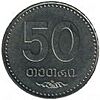 |
 |
50 Tetri | 24 mm | 6.52 g | Stainless Steel | Smooth | The number “50” and the word თეთრი (tetri). | The coat of arms of Georgia, with sun rays around it. The words საქართველო and the year “2006”. |
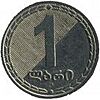 |
 |
1 Lari | 26.2 mm | 7.85 g | Copper-nickel | Reeded with words: Georgia in Georgian and English | The number “1” and the word ლარი (lari). | The coat of arms of Georgia, the word საქართველო on the top left, and the year “2006” on the bottom right. |
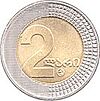 |
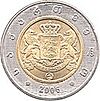 |
2 Lari | 27 mm | 8 g | Two metals: Copper-aluminium-nickel in the middle, Copper-nickel ring | Reeded with words: Georgia in Georgian and English | The number “2” and the word ლარი (lari). It has a design of sun rays. | The coat of arms of Georgia, with the word საქართველო around the edge, and the year “2006”. |
| First Series (1993) | ||||||||
|---|---|---|---|---|---|---|---|---|
| Image | Value | Technical details | What's on the coin | |||||
| Front | Back | Diameter | Weight | Material | Edge | Front (Obverse) | Back (Reverse) | |
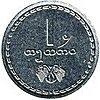 |
 |
1 Tetri | 15 mm | 1.38 g | Stainless Steel | Smooth | The number "1" and the word თეთრი (tetri), with a vine design. | The Borjgali (a Georgian sun symbol with seven rays) over the Christian Tree of Life. The year “1993”, and the words საქართველოს რესპუბლიკა and "Republic of Georgia". |
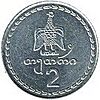 |
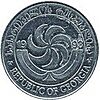 |
2 Tetri | 17.5 mm | 1.9 g | Stainless Steel | Smooth | A Peacock with open wings, the word თეთრი (tetri) and the number “2”. | |
 |
 |
5 Tetri | 20 mm | 2.5 g | Stainless Steel | Smooth | A golden lion statue from an ancient burial mound. The number “5”, and the word თეთრი (tetri). | |
 |
 |
10 Tetri | 21.9 mm | 3 g | Stainless Steel | Smooth | Saint Mammes riding a lion, from an 11th-century silver plate. The number “10” and the word თეთრი (tetri). | |
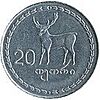 |
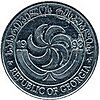 |
20 Tetri | 25 mm | 5 g | Stainless Steel | Smooth | A stag from a painting by Georgian artist Niko Pirosmanashvili. The number “20” and the word თეთრი (tetri). | |
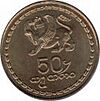 |
 |
50 Tetri | 19 mm | 2.45 g | Brass | Smooth | A Griffin from the 11th-century Samtavisi Cathedral. The number “50”, and the word თეთრი (tetri). | |
Lari Banknotes
New Banknotes (2016–2019)
Between November 2016 and October 2019, the National Bank of Georgia released a new set of five banknotes. These are in values of ₾5, ₾10, ₾20, ₾50, and ₾100. These new Lari notes are printed by the Polish Security Printing Works.
| Image | Value | Size | Main color | What's on it | Date of | ||||||
|---|---|---|---|---|---|---|---|---|---|---|---|
| Front | Back | Front | Back | printing | issue | ||||||
 |
 |
₾5 (Khuti lari) | 122 × 62 mm | Brown | A picture of Georgian author Ivane Javakhishvili and the main building of the Ivane Javakhishvili Tbilisi State University. | Details from Niko Pirosmani's paintings Threshing and Fisherman in a Red Shirt, plus Georgia's coat of arms. | 2017 | 1 September 2017 | |||
 |
 |
₾10 (Ati lari) | 127 × 64 mm | Blue | A picture of Georgian author Akaki Tsereteli and a part of his poem Spring. | A detail from Georgian artist David Kakabadze's painting Imereti - My Mother, and Georgia's coat of arms. | 2019 | 1 October 2019 | |||
 |
 |
₾20 (Otsi lari) | 132 × 66 mm | Magenta | A picture of Ilia Chavchavadze, with his magazines Sakartvelos Moambe and Iveria, and his personal items. | A statue of King Vakhtang Gorgasali, an 18th-century map of Tbilisi, and a view of old Tbilisi with Narikala fortress. Also, Georgia's coat of arms. | 2016 | 1 February 2016 | |||
 |
 |
₾50 (Ormotsdaati lari) | 137 × 68 mm | Green | A picture of Georgian Queen Tamar, the Vardzia cave monastery, and a carving from the Pitareti Virgin Mary Monastery. | A miniature of a Sagittarius from a 12th-century book, and Georgia's coat of arms. | 2016 | 1 February 2016 | |||
 |
 |
₾100 (Asi lari) | 142 × 70 mm | Violet | A picture of Georgian poet Shota Rustaveli, an illustration from his poem The Knight in the Panther's Skin, and a carving of Daniel in the lions' den. | The Georgian National Opera Theater, a part of the Georgian national anthem's music, and Georgia's coat of arms. | 2016 | 1 November 2016 | |||
| These images are to scale at 0.7 pixel per millimetre. For table standards, see the banknote specification table. | |||||||||||
Older Banknotes
The National Bank of Georgia announced that Lari banknotes from 1995 to 1999 (values ₾1, ₾2, ₾5, ₾10, ₾20, ₾50, and ₾100) would no longer be valid money after January 1, 2022. From that date, you can only exchange these older notes at the National Bank of Georgia.
| Image | Value | Size | Main color | What's on it | Date of | Notes | |||||
|---|---|---|---|---|---|---|---|---|---|---|---|
| Front | Back | Front | Back | printing | issue | withdrawal | |||||
 |
 |
₾1 (Erti lari) | 115 × 61 mm | Green/Grey | A picture of Georgian artist Niko Pirosmanashvili (Pirosmani). | A view of Tbilisi, Georgia's capital, and a picture of a stag from Pirosmani's painting. | 2002 | 5 August 2002 | Replaced by coins in 2006 | ||
 |
 |
₾2 (Ori Lari) | 115 × 61 mm | Green/Orange | A picture of Georgian composer Zacharia Paliashvili and music notes from his opera. | The building of the Tbilisi Zacharia Paliashvili Opera and Ballet State Theatre. | 2002 | 5 August 2002 | Replaced by coins in 2006 | ||
 |
 |
₾5 (Khuti lari) | 115 × 61 mm | Brown | A picture of Georgian academic Ivane Javakhishvili. | The main building of the Ivane Javakhishvili Tbilisi State University with an open book. | 2002 | 5 August 2002 | |||
 |
 |
₾10 (Ati lari) | 125 × 63 mm | Blue | A picture of Georgian poet Akaki Tsereteli, a swallow, and a blossoming branch. | A detail from Georgian artist David Kakabadze's painting Imereti - My Mother and a vine. | 2002 | 5 August 2002 | |||
 |
 |
₾20 (Otsi lari) | 131 × 65 mm | Navy yellow | A picture of Georgian public figure Ilia Chavchavadze, his magazines, and personal items. | A statue of King Vakhtang Gorgasali, an 18th-century map of Tbilisi, and a view of old Tbilisi with Narikala fortress. | 2002 | 5 August 2002 | |||
 |
 |
₾50 (Ormotsdaati lari) | 135 × 66 mm | Navy green | A picture of 12th-century Georgian Queen Tamar and a griffin. | A "Sagittarius astrological sign" from a 12th-century Georgian book. | 2004 | 9 November 2004 | |||
 |
 |
₾100 (Asi lari) | 140 × 67 mm | Light green | A picture of Shota Rustaveli and angels raising a cross. | A scene from the Bible story "Daniel in the den of lions" from the Martvili monastery. | 2004 | 9 November 2004 | |||
 |
 |
₾200 (Orasi lari) | 146 × 72 mm | Yellow | A picture of Kakutsa Cholokashvili with parts of Georgian cultural art in the background. | The city of Sukhumi and parts of an old church screen from the village Tsebelda. | 2006 | 15 April 2007 | |||
 |
 |
₾500 (Khutasi lari) | 143 × 66 mm | Green | A picture of David IV. | Old Georgian writings and a cross. | 1995 | This banknote was never officially released. | |||
| These images are to scale at 0.7 pixel per millimetre. For table standards, see the banknote specification table. | |||||||||||
| Current GEL exchange rates | |
|---|---|
| From Google Finance: | AUD CAD CHF EUR GBP HKD JPY USD RUB TRY |
| From Yahoo! Finance: | AUD CAD CHF EUR GBP HKD JPY USD RUB TRY |
| From XE.com: | AUD CAD CHF EUR GBP HKD JPY USD RUB TRY |
| From OANDA: | AUD CAD CHF EUR GBP HKD JPY USD RUB TRY |
| From fxtop.com: | AUD CAD CHF EUR GBP HKD JPY USD RUB TRY |
| Preceded by: Georgian kupon lari Reason: Replaced the Soviet and Russian ruble as a temporary currency |
Currency of Georgia April 5, 1993 – October 2, 1995 |
Succeeded by: Georgian lari Reason: Because of very fast price increases (hyperinflation) Ratio: 1 Georgian lari = 1,000,000 Georgian kuponi |
| Preceded by: Georgian kuponi lari Reason: Because of very fast price increases (hyperinflation) Ratio: 1 Georgian lari = 1,000,000 Georgian kuponi lari |
Currency of Georgia October 2, 1995 – |
Succeeded by: Current |
See also
- Economy of Georgia (country)
- Larization









